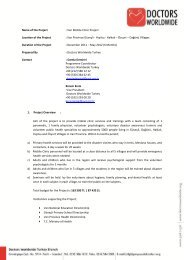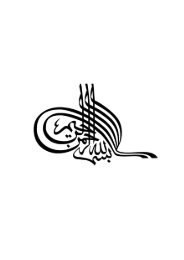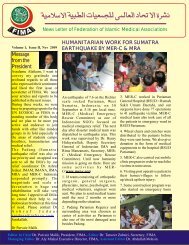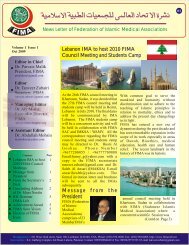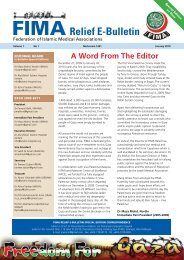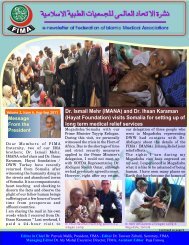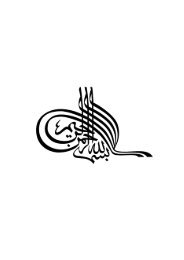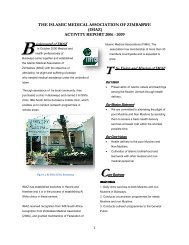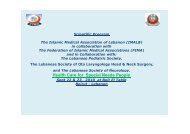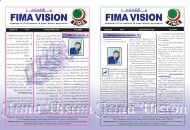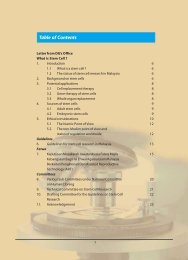FIMA Year Book 2009 - Federation of Islamic Medical Associations
FIMA Year Book 2009 - Federation of Islamic Medical Associations
FIMA Year Book 2009 - Federation of Islamic Medical Associations
You also want an ePaper? Increase the reach of your titles
YUMPU automatically turns print PDFs into web optimized ePapers that Google loves.
Muslim ContributionsThe rise <strong>of</strong> the Madrasah systemand the compartmentalisation <strong>of</strong>knowledge.Some writers suggest that the‘Madrasah’(school) system was one<strong>of</strong> the contributing factors for thedecline <strong>of</strong> sciences in Islam. TheMadrasah system flourished afterthe first Madrasah called MadrasahNizamiyyah was established inBaghdad by Nizam al-Mulk in 459Hijri (1067 C.E .) that favored thestudy <strong>of</strong> theology and law (29) . Thissystem unfortunately divided theinstitutions for the study <strong>of</strong> sciencesand theology. <strong>Medical</strong> sciences andother sciences were studied in variousplaces like medical schools or hospitals,observatories, libraries, academies andunder individual renowned scientistssupported by the rulers. Madaris (sing.Madrasah) meanwhile were developedby powerful and wealthy individualswho contributed their wealth to supportthem. The purpose <strong>of</strong> establishing theseMadaris was always religious and theywere the forerunners <strong>of</strong> the collegesystem in Western Universities (30) .However while Western universitiescombined colleges for theology, law,arts, science and medicine, Madarisonly concentrated on theology andlaw. Madrasas run by independentindividuals continued to exist withoutany interruption whereas other centers<strong>of</strong> study for sciences which weredependent on prosperity <strong>of</strong> the statedeteriorated and disappeared with thedecline <strong>of</strong> <strong>Islamic</strong> states. Madaris runby individuals ended up propagatinga particular individual’s paradigms <strong>of</strong>education and Islam. This contributedto “secularisation <strong>of</strong> knowledge” and“Tunnel Vision Syndrome” <strong>of</strong> presentday Muslim societies.Geographical factors and naturaldisasters.Most <strong>of</strong> the then <strong>Islamic</strong> regionsconsisted <strong>of</strong> arid or semi-arid landswith only a small proportion <strong>of</strong>scattered heavily inhabited areas.These inhabited areas were alsodependent on irrigation and because <strong>of</strong>lack <strong>of</strong> enough rainfall in these areas,it was not sufficient for agriculture.The only productive agricultural areaswere located along the great rivers<strong>of</strong> Nile, the Euphrates and the Tigrisbut individuals were unable to takeadvantage <strong>of</strong> this water and centralgovernments were responsible fordeveloping the irrigation system. Withthe decline <strong>of</strong> central governments,irrigation works were neglected andagriculture was affected severely.Small agricultural lands became aridand economy and civilization <strong>of</strong> thewhole region were destroyed. Naturaldisasters are another important factorcontributing to the depopulation<strong>of</strong> <strong>Islamic</strong> regions especially Egypt,Syria and Iraq in the middle ages (31) .A famine caused by low levels <strong>of</strong> Nilein 968 C.E. resulted in death <strong>of</strong> about600,000 people. Between 1201-1202C.E. a famine was followed by plaguein Egypt and caused death <strong>of</strong> largenumber <strong>of</strong> people. The plague between1347-1349 C.E., known as Black Death,<strong>FIMA</strong> <strong>Year</strong><strong>Book</strong> <strong>2009</strong>110




